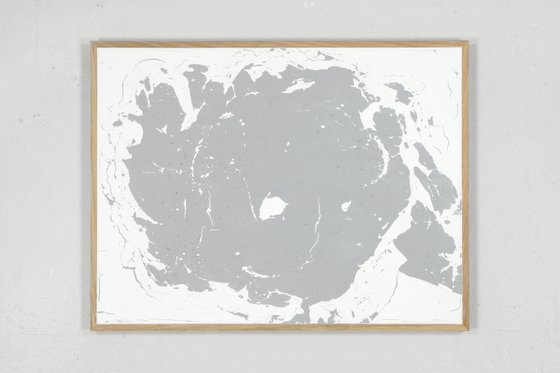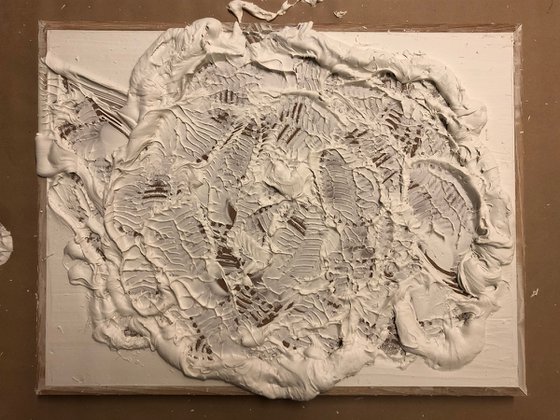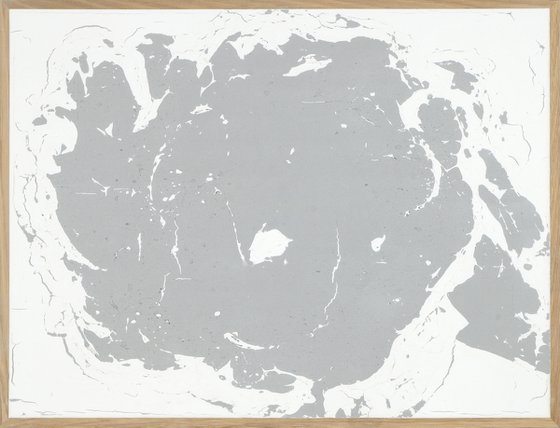- By medium
- By subject
- By budget
- Sales
- Gift cards
- Discover all art
- Artists
- Editors’ picks
- Ideas

#298 Tantrum
$1,364.76
Original artwork description:
64x84 cm | Filler, oak frame
This work was done by jumping up and down in the wet filler inside a frame placed on the floor, wearing plastic clogs.
A child's outburst of rage when it does not get its way is something every parent need to handle. They usually decrease as the child gets older. This process of socialisation is very much about language. We teach the child to use words to express its will. But language also is part of defining the subject as such. That is, to draw the boundary between the subject and the outside world that is fundamental to its existence. Arguably, this semantic demarcation is what constitutes the subject. When the child learns to express its will in words, it becomes an independent individual with a consciousness that distinguishes it from the outside world. Before this happens, the boundary is unclear. In a way, the child still experiences the world as a part of itself.
The subject's initial experience of independence is thus linked to powerlessness. Not being able to enforce one's wishes is primordial to developing a will, i.e. being a subject. The will creates itself through negation. It can be described as an implosion or disturbance in the fragile alloy between the yet undeveloped individual and the world around it. The subject's Big Bang. The explosion that opens up the space for language that enables its existence.
The function of the tantrum can be linked to the mechanisms behind riots. The powerless are not yet aware of their own will, their own position as a subject. It is only through the spontaneous outburst that the group or class can identify themselves and thus win agency. The riot always arises from the material - it has a physical expression - but it opens up the semantic space that the powerless need to formulate their own position in a system of oppression - which is a necessary condition for struggle.
Clogs
The shoes wore to produce this work is a modern variant of clogs, made of plastic. This is the shoe of the common people, the shoe of the working class. Historically made in wood for use in factories and on the fields, but today, for example, healthcare workers widely use the plastic version. It is also popular as leisurewear for the mainstream, or the so-called masses.
Platform
This work is part of a series called Platform. Works made by bodily imprints in frames with wet filler while placed on the ground. This is inspired by Gutai, the experimental Japanese art group from the 50s, who focused on matter, body and process, and especially one member Kazuo Shiraga who painted with his feet, suspended from the ceiling over the canvas. These imprints can be made by me or others, to document, or record, an event taking place at a certain point in time. The happening is becoming the act that creates a work of art and thus challenging the boundary between documentation of art and art itself.
Materials used:
Filler (coarse and fine) in oak frame
Tags:
#abstract #painting #minimalism #filler #oak frame#298 Tantrum (2020) Painting
by Johan Söderström
1 Artist Reviews
$1,364.76
- Painting on Panel / Board / MDF
- One of a kind artwork
- Size: 33.07 x 25.2 x 1.97" (framed)
- Framed and ready to hang
- Signed on the back
- Style: Expressive and gestural
- Subject: Abstract and non-figurative
Loading
Original artwork description
64x84 cm | Filler, oak frame
This work was done by jumping up and down in the wet filler inside a frame placed on the floor, wearing plastic clogs.
A child's outburst of rage when it does not get its way is something every parent need to handle. They usually decrease as the child gets older. This process of socialisation is very much about language. We teach the child to use words to express its will. But language also is part of defining the subject as such. That is, to draw the boundary between the subject and the outside world that is fundamental to its existence. Arguably, this semantic demarcation is what constitutes the subject. When the child learns to express its will in words, it becomes an independent individual with a consciousness that distinguishes it from the outside world. Before this happens, the boundary is unclear. In a way, the child still experiences the world as a part of itself.
The subject's initial experience of independence is thus linked to powerlessness. Not being able to enforce one's wishes is primordial to developing a will, i.e. being a subject. The will creates itself through negation. It can be described as an implosion or disturbance in the fragile alloy between the yet undeveloped individual and the world around it. The subject's Big Bang. The explosion that opens up the space for language that enables its existence.
The function of the tantrum can be linked to the mechanisms behind riots. The powerless are not yet aware of their own will, their own position as a subject. It is only through the spontaneous outburst that the group or class can identify themselves and thus win agency. The riot always arises from the material - it has a physical expression - but it opens up the semantic space that the powerless need to formulate their own position in a system of oppression - which is a necessary condition for struggle.
Clogs
The shoes wore to produce this work is a modern variant of clogs, made of plastic. This is the shoe of the common people, the shoe of the working class. Historically made in wood for use in factories and on the fields, but today, for example, healthcare workers widely use the plastic version. It is also popular as leisurewear for the mainstream, or the so-called masses.
Platform
This work is part of a series called Platform. Works made by bodily imprints in frames with wet filler while placed on the ground. This is inspired by Gutai, the experimental Japanese art group from the 50s, who focused on matter, body and process, and especially one member Kazuo Shiraga who painted with his feet, suspended from the ceiling over the canvas. These imprints can be made by me or others, to document, or record, an event taking place at a certain point in time. The happening is becoming the act that creates a work of art and thus challenging the boundary between documentation of art and art itself.
Materials used:
Filler (coarse and fine) in oak frame
Tags:
#abstract #painting #minimalism #filler #oak frame14 day money back guaranteeLearn more
Artist Reviews (1)
Recently viewed
- Loading items







